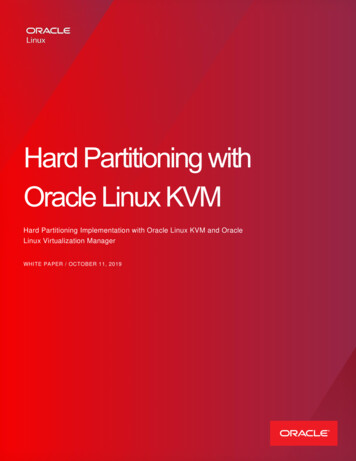
Transcription
Hard Partitioning withOracle Linux KVMHard Partitioning Implementation with Oracle Linux KVM and OracleLinux Virtualization ManagerWHITE PAPER / OCTOBER 11, 2019
INTRODUCTIONThis document describes hard partitioning with Oracle Linux KVM inconjunction with Oracle Linux Virtualization Manager, and how to use it toconform to the Oracle Licensing policies for partitioned environments.CPU CORES AND CPU THREADSOn an x86-based system, a CPU core (no hyperthreading enabled) or a CPU thread (hyperthreadingenabled) within a core is presented as a physical CPU by the hypervisor or the bare metal operatingsystem. vCPUs (virtual CPUs) are exposed to the guest virtual machine as CPUs: the guest schedulesapplications on these vCPUs, and the hypervisor schedules these vCPUs over the physical CPU coresor threads. All vCPUs from a guest are symmetrical. Oracle Linux KVM treats these equally, as longas scheduling parameters such as using CPU pinning have not changed.Oracle Linux KVM offers an advanced feature for hard partitioning, also known as CPU pinning. Hardpartitioning means binding vCPUs to physical CPU threads or cores, and preventing these vCPUsfrom being scheduled on physical CPUs - threads or cores other than the ones specified.ORACLE HARD PARTITIONING LICENSINGTo conform to the Oracle hard partition licensing requirement, you must follow the instructionsdescribed in this white paper to bind vCPUs to physical CPU threads or cores.Live migration of CPU pinned virtual machines to another Oracle Linux KVM node is not permittedunder the terms of the hard partitioning license. Consequently, the cluster that is a pool of OracleLinux KVM nodes with shared storage must not be configured with any scheduling policy available onOracle Linux Virtualization Manager.When live migration is used with pinned virtual machines running Oracle software in an Oracle LinuxKVM cluster, hard partition licensing for Oracle software is not applicable. You must determine thenumber of virtual machines running the Oracle software and then license the same number of physicalservers (starting with the largest servers based on the CPU core count) up to the total number of thephysical servers in the cluster. For example, if a customer has a cluster with 32 servers and 20 virtualmachines running Oracle software within the cluster, the customer must license the 20 largest physicalservers in the cluster. If the customer is running 50 virtual machines with Oracle software in a clusterof 32 physical servers, they need only to license the 32 physical servers in the cluster.Live migration of other virtual machines with non-Oracle software within the server pool is not relevantto Oracle software hard partitioning or has no impact to how Oracle software license is calculated.“Trusted Partitions” allow subset licensing without limitation on live migration, but only available on theapproved Oracle Engineered Systems listed on Oracle licensing policies for partitioned environments.2WHITE PAPER / Hard Partitioning with Oracle Linux KVM
UNDERSTANDING CPU TOPOLOGY IN ORACLE LINUX KVMOn a server running Oracle Linux KVM, you can run the "lscpu” command to print out the basic CPUconfiguration of the server hardware. Look for the lines below in the output for detail on your system’sCPUs.# lscpuArchitecture:CPU op-mode(s):Byte Order:CPU(s):On-line CPU(s) list:Thread(s) per core:Core(s) per socket:Socket(s):NUMA node(s):Vendor ID:CPU family:Model:Model name:Stepping:CPU MHz:CPU max MHz:CPU min MHz:BogoMIPS:Virtualization:L1d cache:L1i cache:L2 cache:L3 cache:NUMA node0 CPU(s):NUMA node1 CPU(s):x86 6432-bit, 64-bitLittle Endian1040-10322622GenuineIntel685Intel(R) Xeon(R) Platinum 8167M CPU @ K1024K36608K0-25,52-7726-51,78-103Some considerations on the output above: This server has 2 sockets with 26 cores and 2 threads per core. Total of 104 "CPUs"CPU 0.103 is really thread 0.103NUMA node0 includes threads 0-25 and 52-77NUMA node1 includes threads 25-61 and 78-103Get the CPU Topology for vCPU Bindings to Physical CPUsThe command “virsh” , available on an Oracle Linux KVM Server managed by Oracle LinuxVirtualization Manager, can be executed in read-only mode. With this command we can first generatethe list of active virtual machines running locally on the server:# virsh --readonly listId Name State-----------------------------5 win10-b1803 running7 ol7-uek5-it running8 ol6u9-kvm-it running9 debian-9.3 running3WHITE PAPER / Hard Partitioning with Oracle Linux KVM
With the same “virsh” command we can also easily check if the CPUs for a virtual machines arepinned to a physical thread/core:# virsh --readonly vcpuinfo ol7-uek5-it --prettyVCPU:0CPU:1State:runningCPU time:7108.2sCPU Affinity:0-7 (out of 8)VCPU:CPU:State:CPU time:CPU Affinity:13running7081.8s0-7 (out of 8)On this example the virtual machine is configured with 2 vCPUs and both can span from thread/core 0until thread/core 7 (out of 8); so, the virtual CPUs for this virtual machines are not pinned to physicalthreads/cores.Virtual machines with vCPUs pinned to physical threads/cores, can be easily identified with the limited“CPU Affinity” compared to the total number of physical threads/cores (out of number):# virsh --readonly vcpuinfo ol8-rc1 --prettyVCPU:0CPU:4State:runningCPU time:17.5sCPU Affinity:3-4 (out of 8)VCPU:CPU:State:CPU time:CPU Affinity:14running1.6s3-4 (out of 8)CONFIGURING HARD PARTITIONINGSetting Hard Partitioning using the Oracle Linux Virtualization Manager UtilityThe server running Oracle Linux KVM must meet the requirements as Oracle Linux KVM computehost defined in the Oracle Linux Virtualization Manager Installation Guide. You must use theolvm vmcontrol utility to set and get the CPU/vCPU bindings for a virtual machine running on OracleLinux KVM through the Oracle Linux Virtualization Manager.The olvm vmcontrol utility is available in Oracle Linux 7 channel from Oracle Linux Yum Server orUnbreakable Linux Network (ULN). Please review the man page file in the RPM for additionalinformation on the utility and the commands that can be executed and the Oracle Linux VirtualizationManager Documentation.The olvm vmcontrol utility can run on the host running Oracle Linux Virtualization Manager or aseparate Oracle Linux host that has connectivity to the Oracle Linux Virtualization Manager. Beforerunning the utility, make sure that the utility version matches the version of the Oracle LinuxVirtualization Manager.To install the utility, you first need to install the required RPM containing them:# yum install olvm-vmcontrol4WHITE PAPER / Hard Partitioning with Oracle Linux KVM
Once installed the “olvm-vmcontrol” utility is available on the Linux system path:# which olvm-vmcontrol/usr/bin/olvm-vmcontrolThe olvm-vmcontro utility requires authentication to the Oracle Linux Virtualization Manager for eachoperation executed. If a large number of operations have to be executed and if you are running theolvm-vmcontrol utility on the same Oracle Linux Virtualization Manager host, it’s suggested to setup anenvironment variable dedicated to the password:# export OLVMUTIL PASS password By specifying the “-e” option and with this environment setting in-place, each operation executed willnot require authentication.In the example below, a virtual machine named ol76 accepts the action getvcpu to show that virtualCPUs of this guest are not bound to any specific thread or core.# olvm-vmcontrol -m ovirt.it.oracle.com -u admin@internal -v ol76 -cgetvcpu -eOracle Linux Virtualization Manager VM Control Utility 4.2.1-8Connected to Oracle Linux Virtualization Manager 4.2.8.2-1.0.8.el7Error: VM migration mode must be set to PINNED ("Do not allow migration")and the VM needs to be pinned to a single host.Migration mode is MIGRATABLENumber of hosts VM is pinned to 0See man page for more details.Let's bind the vCPUs to core 0 by running the following command:# olvm-vmcontrol -m ovirt.it.oracle.com -u admin@internal -v ol76 -csetvcpu -s 0 -eOracle Linux Virtualization Manager VM Control Utility 4.2.1-8Connected to Oracle Linux Virtualization Manager 4.2.8.2-1.0.8.el7Setting vcpu pinning .Trying to pin virtual cpu # 0Trying to pin virtual cpu # 1Retrieving vcpu pinning to confirm it has been set.vcpu 0 pinned to cpuSet[0]vcpu 1 pinned to cpuSet[0]NOTE: if the VM is running you must now stop and then start the VM from theOracle Linux Virtualization Manager in order for CPU pinning changes totake effect.NOTE: a restart or a reboot of the VM is not sufficient to put CPU pinningchanges into effect.Once you have configured a virtual machine for CPU pinning, you need to stop the virtual machineand then start it again before the CPU pinning can take effect; With the virtual machine properlyrestarted we can verify that the proper vCPU pinning is in place:# olvm-vmcontrol -m ovirt.it.oracle.com -u admin@internal -v ol76 -cgetvcpu -eOracle Linux Virtualization Manager VM Control Utility 4.2.1-8Connected to Oracle Linux Virtualization Manager 4.2.8.2-1.0.8.el7Getting vcpu pinning .vcpu 0 pinned to cpuSet[0]vcpu 1 pinned to cpuSet[0]5WHITE PAPER / Hard Partitioning with Oracle Linux KVM
On the server running Oracle Linux KVM, we can also execute the “virsh” command to find out theCPU pinning status:# virsh --readonly vcpuinfo ol76 --prettyVCPU:0CPU:0State:runningCPU time:2.7sCPU Affinity:0 (out of 8)VCPU:CPU:State:CPU time:CPU Affinity:10running0.0s0 (out of 8)The virtual machine now has CPU Affinity 0 for both virtual CPUs.CONCLUSIONWith Oracle Linux Virtualization Manager and Oracle Linux KVM, to conform to the Oracle hardpartition licensing requirement, you must bind a virtual machine to physical CPUs or cores. Thisprevents the software from running on physical cores other than the ones specified. In such a case,virtual machines are configured with dedicated CPU resources instead of the default of resourcescheduling, which is to use all available CPUs of the server. Using hard partitioning to limit Oracleproduct software licensing also adds some restrictions such as live migration and scheduling policiesavailable on Oracle Linux Virtualization Manager.For more information about Oracle's virtualization solutions, visit oracle.com/virtualization.6WHITE PAPER / Hard Partitioning with Oracle Linux KVM
ORACLE CORPORATIONWorldwide Headquarters500 Oracle Parkway, Redwood Shores, CA 94065 USAWorldwide InquiriesTELE 1.650.506.7000FAX 1.650.506.7200oracle.com 1.800.ORACLE1CONNECT WITH USCall 1.800.ORACLE1 or visit oracle.com. Outside North America, find your local office at .com/oracletwitter.com/oracleCopyright 2019, Oracle and/or its affiliates. All rights reserved. This document is provided for information purposes only, and the contents hereof aresubject to change without notice. This document is not warranted to be error-free, nor subject to any other warranties or conditions, whether expressedorally or implied in law, including implied warranties and conditions of merchantability or fitness for a particular purpose. We specifically disclaim anyliability with respect to this document, and no contractual obligations are formed either directly or indirectly by this document. This document may not bereproduced or transmitted in any form or by any means, electronic or mechanical, for any purpose, without our prior written permission.Oracle and Java are registered trademarks of Oracle and/or its affiliates. Other names may be trademarks of their respective owners.Intel and Intel Xeon are trademarks or registered trademarks of Intel Corporation. All SPARC trademarks are used under license and are trademarks orregistered trademarks of SPARC International, Inc. AMD, Opteron, the AMD logo, and the AMD Opteron logo are trademarks or registered trademarksof Advanced Micro Devices. UNIX is a registered trademark of The Open Group. 1019White Paper Hard Partitioning with Oracle Linux KVMOctober 2019
Linux KVM through the Oracle Linux Virtualization Manager. The olvm_vmcontrol utility is available in Oracle Linux 7 channel from Oracle Linux Yum Server or Unbreakable Linux Network (ULN). Please review the man page file in the RPM for additional information on the utility and the commands that can be exec











